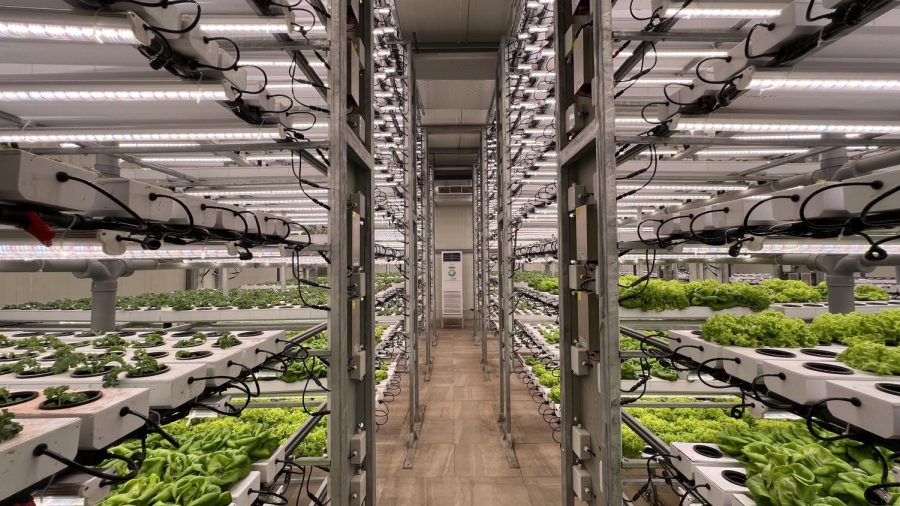Vertical Farming: Something Worth Arguing?
thoughts on vertical farming and its appearance on the ap language exam
Whether it be known for what it is, or for the stress that it put students through, vertical farming is a hot topic in the halls of Oakton. On the 2023 AP Language and Composition Exam, Juniors awaited three essays, and most notably, for the synthesis style essay, students were tasked to articulate an argument on vertical farming based off of information in given documents. Despite the prior knowledge of vertical farming that students may or may not have had, this innovative technique may be worth mentioning for future development in agriculture.
So what is vertical farming? This progressive and resourceful farming technique offers both pros and cons, but addresses an important and relevant global issue. In the effort to aid the world’s growing population and limited farmland, vertical farming could come in clutch in the future. Vertical farming is a new agricultural process that grows plants and crops in a vertical manner rather than on a traditional field. Vertical farms are typically grown in unused shipping containers, greenhouses, or even warehouses. This new technique allows for more efficiency, as it uses far less land as traditional farming would require, and is able to grow substantially more crops as they can grow in an upward direction. Not only does vertical farming save space, but it conserves water as well. On traditional style farms, up to 40% of water is lost due to evaporation, faulty irrigation, and unmanaged water control, but vertical farming offers multiple solutions. The issue in this situation is that the environment is mostly at fault, but because vertical farms are grown indoors, there is no water lost to evaporation, and excess water recycles itself due to the vertical manor of the system. Vertical farming uses 98% less water than traditional farming, and this is revolutionary, considering 70% of water used annually across the globe is credited to farming. In addition to this, vertical farming allows for rapidly increased production of crops as they can be grown year round. This new technique is not dependent upon seasonal growing conditions, and this offers even more benefits. Vertical farming helps with food security in places that would normally not have enough food due to climate conditions. Furthermore, the controlled environment eliminates crop failures due to animals and insects. Vertical farming also uses less chemicals and pesticides because of the controlled environment. As a technique that can be grown or used anywhere, this greatly helps highly populated areas as these farms take up minimal space.
At this point, Vertical farming sounds perplexing, but there are many cons to this seemingly beneficial innovation. Firstly, vertical farming is extremely reliant on the newly advanced technology. The technology used in these farms accurately controls the environment of the crops, and the use of smart sensors control temperature, light, irrigation and much more. The high reliance on technology may seem like a risk worth taking, but could easily end in crop failures. Vertical farming is also very expensive, because of the numerous materials needed to construct, as well as the cost of technology needed to maintain the crop conditions, vertical farming can get pretty pricey. This has a direct impact on lower income families. While vertical farming proves to be an ideal solution in places without the availability of farming, lower income families could not benefit. Due to the expenses needed to run the farms, the produce and crops sold from these farms are high in price. So the attempt to help food security gets lost in the cost.
The question is, is vertical farming the way to go for the future? Some Oakton students have reflected on this topic after having taken the AP language exam. It’s easy to see both sides of this issue, and students who took the AP language exam had to ultimately choose a side, and defend their argument. Oakton students were interviewed on the side that they argued and what their thoughts on the topics were. Oakton student Erin Green, 11, was for vertical farming. “[I] already knew about some environmentally friendly farming techniques, and I thought that vertical farming was a good solution.” Green elaborated on why she chose to side with vertical farming saying, “[it’s] good for reducing materials [because] they used shipping containers.” Green also mentioned that this innovative technique produces high quality food, however, touches on the troubling question of cost, “it costs so much money, [I] thought it would be less.” While Green touches on the pluses of vertical farming, it is of the same ease to recognize the negatives. Furthermore, Oakton student Chloe Kim, 11, was against vertical farming, saying that the ‘expense is excessive.” While expressing her appreciation for the intriguing prompt, Kim elaborates, saying that “[I] was surprised that it didn’t use soil.” While both students have differing views on the topic, is there a more favorable argument, or is there a settlement.
While there are seemingly more advantages to vertical farming, the few disadvantages seem to outweigh the benefits. While there are many who may agree with vertical farming, it is important to recognize one of the main reasons to integrate vertical farming in the future, and that is to help feed the world’s growing population. If this new technique is too expensive to upkeep in all parts of the world in different demographics, does this not favor those who can afford this new technology?

I am a Senior this year at Oakton and this is my third year on the Oakton Outlook. I am super excited to be one of the Editors-in-Chief this year! I love...






